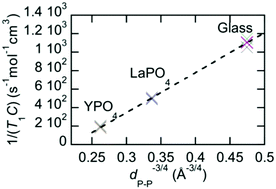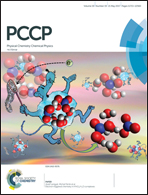Determination of paramagnetic concentrations inside a diamagnetic matrix using solid-state NMR†
Abstract
The determination of very low doping levels in solid materials is an important issue for many applications. When considering paramagnetic dopants, the NMR relaxation technique appears to be much more accurate than classical techniques such as Vegard's law resulting from X-ray diffraction (XRD) measurements or chemical analysis that cannot provide information on appropriate dopant spatial distributions. In a recent report, the linear variation of 1/T1, i.e. the nuclear relaxation rate, as a function of Nd3+ content has been used to determine doping levels with a good dispersion homogeneity in the monazite LaPO4 matrix down to 0.1 mol%. We here extend this study to more complex compounds doped with Nd3+, such as YPO4, the solid solution Y0.8Sc0.2PO4, Ba5(PO4)3Cl and a phosphate glass. For all considered compounds except Ba5(PO4)3Cl:Nd, 1/T1 is found to be linearly proportional to the nominal Nd concentration, confirming the ability of the method to investigate the dopant concentration and spatial homogeneity. The results obtained for different compounds open up the discussion on the parameters, such as the orbital overlap and the average P–P distances, influencing the nuclear relaxation rate.



 Please wait while we load your content...
Please wait while we load your content...